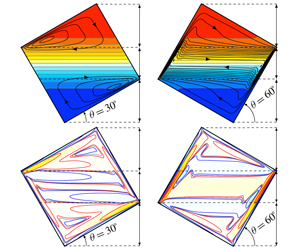Article contents
Dynamics in a stably stratified tilted square cavity
Published online by Cambridge University Press: 29 November 2019
Abstract

The dynamics of a fluid flow in a differentially heated square container is investigated numerically. Two opposite conducting walls are maintained at constant temperatures, one hot and the other cold, and the other two walls are insulated. When the conducting walls are horizontal with the lower one cold, the static linearly stratified state is stable. When the container is tilted, the static equilibrium ceases to exist and the fluid flows due to the baroclinic torque arising from the bending of isotherms near the tilted insulated walls. This flow is found to be steady for tilt angles less than  $45^{\circ }$, regardless of the relative balance between buoyancy and viscous effects (quantified by a buoyancy number
$45^{\circ }$, regardless of the relative balance between buoyancy and viscous effects (quantified by a buoyancy number  $R_{N}$). For tilt angles above
$R_{N}$). For tilt angles above  $45^{\circ }$, the flow becomes unsteady above a critical
$45^{\circ }$, the flow becomes unsteady above a critical  $R_{N}$ with localized boundary layer undulations at the conducting walls, at the heights of the horizontally opposite corners. From these corners emanate horizontal shear layers, which become thinner and more intense with increasing
$R_{N}$ with localized boundary layer undulations at the conducting walls, at the heights of the horizontally opposite corners. From these corners emanate horizontal shear layers, which become thinner and more intense with increasing  $R_{N}$. As the tilt angle approaches
$R_{N}$. As the tilt angle approaches  $90^{\circ }$, the nature of the instability changes, corresponding to that of the well-studied laterally heated cavity flow.
$90^{\circ }$, the nature of the instability changes, corresponding to that of the well-studied laterally heated cavity flow.
- Type
- JFM Papers
- Information
- Copyright
- © 2019 Cambridge University Press
References
- 14
- Cited by


